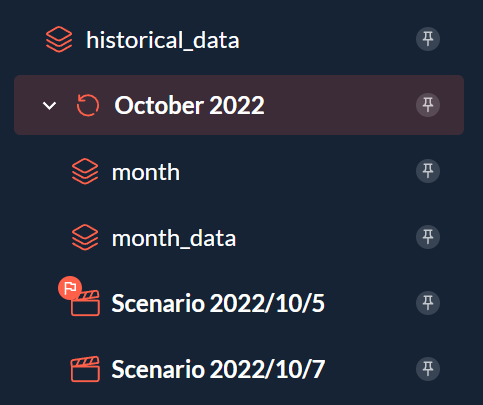Cycles and Scopes
Estimated Time for Completion: 30 minutes; Difficulty Level: Intermediate
In this section, we will explore the intricate relationship between Scopes and Cycles, two core concepts that help manage data nodes and scenarios effectively in Taipy.
Cycles¶
Using Cycles allow you to:
- Share variables between scenarios in the same time frame
For example, if I have three sales prediction scenarios for the month of June, I do not have to duplicate the data for each scenario. I can share the June sales data between the three scenarios.
- Better organize the data nodes in your application

Here we have a single month_data node for all scenarios of October 2022 and it is part of the October 2022 cycle. I do not need to create a new data node for each scenario and clutter my application.
Example: Filtering by Month¶
def filter_by_month(df, month):
df['Date'] = pd.to_datetime(df['Date'])
df = df[df['Date'].dt.month == month]
return df
Configuration¶
Configuration

-
Construct the configuration
-
Add the frequency property for the scenario and put "MONTHLY:FREQUENCY" (DAYLY, WEEKLY, MONTHLY, YEARLY)
-
Load the new configuration in the code
A parameter is added in the scenario configuration for the frequency.
from taipy.config import Frequency
historical_data_cfg = Config.configure_csv_data_node(id="historical_data",
default_path="time_series.csv")
month_cfg = Config.configure_data_node(id="month")
month_values_cfg = Config.configure_data_node(id="month_values")
task_filter_cfg = Config.configure_task(id="filter_by_month",
function=filter_by_month,
input=[historical_data_cfg, month_cfg],
output=month_values_cfg)
scenario_cfg = Config.configure_scenario(id="my_scenario",
task_configs=[task_filter_cfg],
frequency=Frequency.MONTHLY)
Since we have specified frequency=Frequency.MONTHLY, the corresponding scenario when created,
is automatically attached to the correct period (month).
The Cycle which a Scenario belongs to is based on the creation_date of the scenario. It can be "attached" to a specific cycle by manually setting its creation_date, as we are doing in the following example.
tp.Core().run()
scenario_1 = tp.create_scenario(scenario_cfg,
creation_date=dt.datetime(2022,10,7),
name="Scenario 2022/10/7")
scenario_2 = tp.create_scenario(scenario_cfg,
creation_date=dt.datetime(2022,10,5),
name="Scenario 2022/10/5")
Scenario 1 and Scenario 2 are two separate scenario entities created using the same scenario
configuration. They are part of the same Cycle but have different data nodes. By default, each
scenario instance has its own data node instances, and they are not shared with any other scenario.
Interplay between Scopes and Cycles¶
Cycles are generated according to the creation_date of scenarios. The scope, on the other hand, determines how data nodes are shared within these cycles and scenarios.
Scopes¶
Sharing data nodes between entities allows you to organize and manage your data better. It avoids data duplications and allows Taipy to better manage execution (see skippable tasks). The developer may decide:
Scope.SCENARIO(default): Having one data node for each scenario.Scope.CYCLE: Extend the scope by sharing data nodes across all scenarios of a given cycle.Scope.GLOBAL: Expand the scope globally, applying it across all scenarios in all cycles.
Modifying the scope of a Data Node is straightforward. Let's change the configuration of our data nodes:
-
historical_data: is a Global data node. It will be shared by every cycle and scenario.
-
month: is a Cycle data node. All scenarios of the same month will share this data.
-
month_values: same for month_values.
Configuration

-
Change the Scope of historical_data to be global
-
Change the Scope of month_data and month to be Cycle
The configuration is the same as the last step except for the data node configurations. New parameter are added for scopes.
from taipy.config import Frequency, Scope
historical_data_cfg = Config.configure_csv_data_node(id="historical_data",
default_path="time_series.csv",
scope=Scope.GLOBAL)
month_cfg = Config.configure_data_node(id="month", scope=Scope.CYCLE)
month_values_cfg = Config.configure_data_node(id="month_values", scope=Scope.CYCLE)
Defining the month of scenario 1 will also determine the month of scenario 2 since they share the same Data Node.
scenario_1.month.write(10)
print("Month Data Node of Scenario 1:", scenario_1.month.read())
print("Month Data Node of Scenario 2:", scenario_2.month.read())
scenario_1.submit()
scenario_2.submit()
Results:
Month Data Node of Scenario 1: 10
Month Data Node of Scenario 2: 10
In this unusual example where both scenarios are in the same cycle and all their data nodes
are at least with a Cycle Scope, executing one is the same as executing the other as they share
all their data nodes.
Going further into Cycles¶
Primary scenarios¶
In each Cycle, there is a primary scenario. A primary scenario is interesting because
it represents the important scenario of the Cycle, the reference. By default, the
first scenario created for a cycle is primary.
Python code associated to primary scenarios¶
tp.set_primary(<Scenario>)
allows changing the primary scenario in a Cycle.
<Scenario>.is_primary identifies as a boolean whether the scenario is primary or not.
before_set_1 = scenario_1.is_primary
before_set_2 = scenario_2.is_primary
tp.set_primary(scenario_2)
print('Scenario 1: Primary?', before_set_1, scenario_1.is_primary)
print('Scenario 2: Primary?', before_set_2, scenario_2.is_primary)
Results:
Scenario 1: Primary? True False
Scenario 2: Primary? False True
Useful functions on cycles¶
-
tp.get_primary_scenarios(): returns a list of all primary scenarios. -
tp.get_scenarios(cycle=<Cycle>): returns all the scenarios in the Cycle. -
tp.get_cycles(): returns the list of Cycles. -
tp.get_primary(<Cycle>): returns the primary scenario of the Cycle.
Scenario management visual elements¶
You can use Scenario management visual elements to control Cycles. Cycles can be seen in either the
scenario_selector or data_node_selector. Additionally, it's possible to designate a scenario
as primary directly through the scenario visual element.
data_node = None
scenario = None
tp.Gui("""<|{scenario}|scenario_selector|>
<|{scenario}|scenario|>
<|{scenario}|scenario_dag|>
<|{data_node}|data_node_selector|>""").run()

Conclusion¶
By understanding the dynamics between scopes and cycles, developers can effectively manage data nodes and scenarios to suit specific business needs and scenarios. Experiment with different configurations to gain deeper insights into their functionalities and applications.
Entire code¶
from taipy.config import Config, Frequency, Scope
import taipy as tp
import datetime as dt
import pandas as pd
def filter_by_month(df, month):
df['Date'] = pd.to_datetime(df['Date'])
df = df[df['Date'].dt.month == month]
return df
historical_data_cfg = Config.configure_csv_data_node(id="historical_data",
default_path="time_series.csv",
scope=Scope.GLOBAL)
month_cfg = Config.configure_data_node(id="month",
scope=Scope.CYCLE)
month_values_cfg = Config.configure_data_node(id="month_data",
scope=Scope.CYCLE)
task_filter_cfg = Config.configure_task(id="filter_by_month",
function=filter_by_month,
input=[historical_data_cfg, month_cfg],
output=month_values_cfg)
scenario_cfg = Config.configure_scenario(id="my_scenario",
task_configs=[task_filter_cfg],
frequency=Frequency.MONTHLY)
if __name__ == '__main__':
tp.Core().run()
scenario_1 = tp.create_scenario(scenario_cfg,
creation_date=dt.datetime(2022,10,7),
name="Scenario 2022/10/7")
scenario_2 = tp.create_scenario(scenario_cfg,
creation_date=dt.datetime(2022,10,5),
name="Scenario 2022/10/5")
scenario_1.month.write(10)
print("Month Data Node of Scenario 1:", scenario_1.month.read())
print("Month Data Node of Scenario 2:", scenario_2.month.read())
scenario_1.submit()
before_set_1 = scenario_1.is_primary
before_set_2 = scenario_2.is_primary
tp.set_primary(scenario_2)
print('Scenario 1: Primary?', before_set_1, scenario_1.is_primary)
print('Scenario 2: Primary?', before_set_2, scenario_2.is_primary)
scenario = None
data_node = None
tp.Gui("""<|{scenario}|scenario_selector|>
<|{scenario}|scenario|>
<|{scenario}|scenario_dag|>
<|{data_node}|data_node_selector|>""").run()